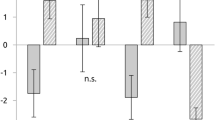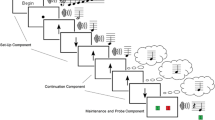Abstract
Neural correlates of the often-powerful emotional responses to music are poorly understood. Here we used positron emission tomography to examine cerebral blood flow (CBF) changes related to affective responses to music. Ten volunteers were scanned while listening to six versions of a novel musical passage varying systematically in degree of dissonance. Reciprocal CBF covariations were observed in several distinct paralimbic and neocortical regions as a function of dissonance and of perceived pleasantness/unpleasantness. The findings suggest that music may recruit neural mechanisms similar to those previously associated with pleasant/unpleasant emotional states, but different from those underlying other components of music perception, and other emotions such as fear.
This is a preview of subscription content, access via your institution
Access options
Subscribe to this journal
Receive 12 print issues and online access
$209.00 per year
only $17.42 per issue
Buy this article
- Purchase on Springer Link
- Instant access to full article PDF
Prices may be subject to local taxes which are calculated during checkout



Similar content being viewed by others
References
Davis, W. B. & Thaut, M. H. The influence of preferred relaxing music on measures of state anxiety, relaxation, and physiological responses. J. Music Ther. 26, 168– 187 (1989).
Krumhansl, C. L. An exploratory study of musical emotions and psychophysiology. Can. J. Exp. Psychol. 51, 336–352 (1997).
Krumhansl, C. L. Cognitive Foundations of Musical Pitch; Oxford Psychology Series No. 17 (Oxford Univ. Press, New York, 1990).
Milner, B. A. in Interhemispheric Relations and Cerebral Dominance (ed. V. Mountcastle) 177–195 (Johns Hopkins Univ. Press, Baltimore, Maryland, 1962).
Zatorre, R. J. Pitch perception of complex tones and human temporal-lobe function. J. Acoust. Soc. Am. 84, 566–572 (1988).
Zatorre, R. J. & Samson, S. Role of the right temporal neocortex in retention of pitch in auditory short-term memory. Brain 114, 2403–2417 (1991).
Zatorre, R. J., Evans, A. C., Meyer, E. & Gjedde, A. Lateralization of phonetic and pitch processing in speech perception. Science 256, 846–849 (1992).
Binder, J. R. et al. Human brain language areas identified by functional MRI. J. Neurosci. 17, 353–362 (1997).
Zatorre, R. J., Evans, A. C. & Meyer, E. Neural mechanisms underlying melodic perception and memory for pitch. J. Neurosci. 14, 1908– 1919 (1994).
Peretz, I., Gagnon, L. & Bouchard, B. Music and emotion: perceptual determinants, immediacy and isolation after brain damage. Cognition 68, 111–141 (1998).
Goldstein, A. Thrills in response to music and other stimuli. Physiol. Psychol. 8, 126–129 (1980).
Dowling, W. J. & Harwood, D. L. Music Cognition 62–89; 202–224 (Academic, Orlando, Florida, 1986).
Sloboda, J. A. Music structure and emotional response: some empirical findings. Psychol. Music 19, 110–120 (1991).
Robazza, C., Macaluso, C. & D'Urso, V. Emotional reactions to music by gender, age, and expertise. Percept. Mot. Skills 79, 939– 944 (1994).
Talairach, J. & Tournoux, P. Co-Planar Stereotaxic Atlas of the Human Brain (Thieme, New York, 1988).
Petrides, M. & Pandya, D. N. Comparative architectonic analysis of the human and the macaque frontal cortex. Handbook Neuropsychol. 9, 17–58 (1994).
Zola-Morgan, S., Squire, L. R., Amaral, D. G. & Suzuki, W. A. Lesions of perirhinal and parahippocampal cortex that spare the amygdala and hippocampal formation produce severe memory impairment. J. Neurosci. 9, 4355–4370 (1989).
Bunsey, M. & Eichenbaum, H. Critical role of the parahippocampal region for paired-associate learning in rats. Behav. Neurosci. 107, 740–747 (1993).
Aguirre, G. K., Detre, J. A., Alsop, D. C. & D'Esposito, M. The parahippocampus subserves topographical learning in man. Cereb. Cortex 6, 823–829 (1996).
Stefanacci, L., Suzuki, W. A. & Amaral, D. G. Organization of connections between the amygdaloid complex and the perirhinal and parahippocampal cortices in macaque monkeys. J. Comp. Neurol. 375, 552– 582 (1996).
Lane, R. D. et al. Neuroanatomical correlates of pleasant and unpleasant emotion. Neuropsychologia 35, 1437– 1444 (1997).
Berthoz, A., Parietal and hippocampal contribution to topokinetic and topographic memory. Phil. Trans. R. Soc. Lond. B 352, 1437– 1448 (1997).
Le, T. H., Pardo, J. V. & Hu, X. 4T-fMRI study of nonspatial shifting of selective attention: cerebellar and parietal contributions. J. Neurophysiol. 79, 1535–1548 (1998).
LeDoux, J. E. Emotional memory systems in the brain. Behav. Brain Res. 58, 69–79 (1993).
Wheeler, R. E., Davidson, R. J. & Tomarken, A. J. Frontal brain asymmetry and emotional reactivity: a biological substrate of affective style. Psychophysiology 30, 82–89 (1993).
Rolls, E. T., Hornak, J., Wade, D. & McGrath, J. Emotion-related learning in patients with social and emotional changes associated with frontal lobe damage. J. Neurol. Neurosurg. Psychiatry 57, 1518–1524 (1994).
George, M. S. et al. Brain activity during transient sadness and happiness in healthy women. Am. J. Psychiatry 152, 341–351 (1995).
Bechara, A., Tranel, D., Damasio, H. & Damasio, A. R. Failure to respond autonomically to anticipated future outcomes following damage to prefrontal cortex. Cereb. Cortex 6, 215– 25 (1996).
Damasio, A. R., The somatic marker hypothesis and the possible functions of the prefrontal cortex. Phil. Trans. R. Soc. Lond. B 351, 1413–1420 (1996).
Dias, R., Robbins, T. W. & Roberts A. C. Dissociation in prefrontal cortex of affective and attentional shifts Nature 380, 69– 72 (1996).
Hornak, J., Rolls, E. T. & Wade, D. Face and voice expression identification in patients with emotional and behavioural changes following ventral frontal lobe damage. Neuropsychologia 34, 247– 261 (1996).
Drevets, W. C. et al. Subgenual prefrontal cortex abnormalities in mood disorders. Nature 386, 824–827 (1997).
Lane, R. D., Reiman, E. M., Ahern, G. L., Schwartz, G. E. & Davidson, R. J. Neuroanatomical correlates of happiness, sadness, and disgust. Am. J. Psychiatry 154, 926–933 (1997).
Paradiso, S. et al. Emotional activation of limbic circuitry in elderly normal subjects in a PET study. Am. J. Psychiatry 154, 384–389 (1997).
Zald, D. H. & Pardo, J. V. Emotion, olfaction, and the human amygdala: amygdala activation during aversive olfactory stimulation. Proc. Natl. Acad. Sci. USA 94, 4119– 4124 (1997).
Lane, R. D., Kivley, L. S., Du Bois, M. A., Shamasundara, P. & Schwartz, G. E. Levels of emotional awareness and the degree of right hemispheric dominance in the perception of facial emotion. Neuropsychologia 33, 25– 38 (1995).
Erhan, H., Borod, J. C., Tenke, C. E. & Bruder, G. E. Identification of emotion in a dichotic listening task: event-related brain potential and behavioral findings. Brain Cogn. 37, 286–307 (1998).
Adolphs, R., Tranel, D., Damasio, H. & Damasio, A. R. Fear and the human amygdala. J. Neurosci. 15, 5879– 5891 (1995).
Hugdahl, K. et al. Brain mechanisms in human classical conditioning: a PET blood flow study. Neuroreport 6, 1723– 1728 (1995).
Morris, J. S. et al. A differential neural response in the human amygdala to fearful and happy facial expressions. Nature 383, 812–815 (1996).
Rogan, M. T. & LeDoux, J. E. Emotion: systems, cells, synaptic plasticity. Cell 85, 469– 475 (1996).
Raichle, M. E., Martin, W. R. W., Herscovitch, P., Mintun, M. A. & Markham, J. Brain blood flow measured with intravenous H2(15)O. II. Implementation and validation. J. Nucl. Med. 24, 790–798 (1983).
Fox, P. T. & Raichle, M. E. Stimulus rate dependence of regional cerebral blood flow in human striate cortex, demonstrated by positron emission tomography. J. Neurophysiol. 51, 1109– 1120 (1984).
Collins, D. L., Neelin, P., Peters, T. M. & Evans, A. C. Automatic 3D intersubject registration of MR volumetric data in standardized Talairach space. J. Comput. Assist. Tomogr. 18, 192–205 (1994).
Paus, T., Perry, D. W., Zatorre, R. J., Worsley, K. J. & Evans, A. C. Modulation of cerebral blood flow in the human auditory cortex during speech: role of motor-to-sensory discharges. Eur. J. Neurosci. 8, 2236– 2246 (1996).
Sokal, R. R. & Rohlf, F. J. Biometry 2nd edn (Freeman, San Francisco, California, 1981).
Worsley, K. J., Evans, A. C., Marrett, S. & Neelin, P. A three-dimensional statistical analysis for CBF activation studies in human brain. J. Cereb. Blood Flow Metab. 12, 900–918 (1992).
Acknowledgements
We thank Christine Beckett for assistance in composing the music stimuli used in this experiment, and Pierre Ahad for his expertise in sound technology and computer programming. We also thank the technical staff of the McConnell Brain Imaging Unit and of the Medical Cyclotron Unit for their assistance, and Sylvain Milot for his technical expertise. This work was supported by Grants MT11541 and GR13972 from the Medical Research Council of Canada, by the Jeanne Timmins Costello Fellowship in Neuroscience awarded to A.J.B. by the Montreal Neurological Institute, and by the McDonnell-Pew Cognitive Neuroscience Program.
Author information
Authors and Affiliations
Corresponding author
Rights and permissions
About this article
Cite this article
Blood, A., Zatorre, R., Bermudez, P. et al. Emotional responses to pleasant and unpleasant music correlate with activity in paralimbic brain regions. Nat Neurosci 2, 382–387 (1999). https://doi.org/10.1038/7299
Received:
Accepted:
Issue Date:
DOI: https://doi.org/10.1038/7299
This article is cited by
-
Graph theoretical brain connectivity measures to investigate neural correlates of music rhythms associated with fear and anger
Cognitive Neurodynamics (2024)
-
Spectro-temporal acoustic elements of music interact in an integrated way to modulate emotional responses in pigs
Scientific Reports (2023)
-
Music modulates emotional responses in growing pigs
Scientific Reports (2022)
-
The role of expertise in the aesthetic evaluation of mathematical equations
Psychological Research (2022)
-
What is Beauty?
Aesthetic Plastic Surgery (2021)



